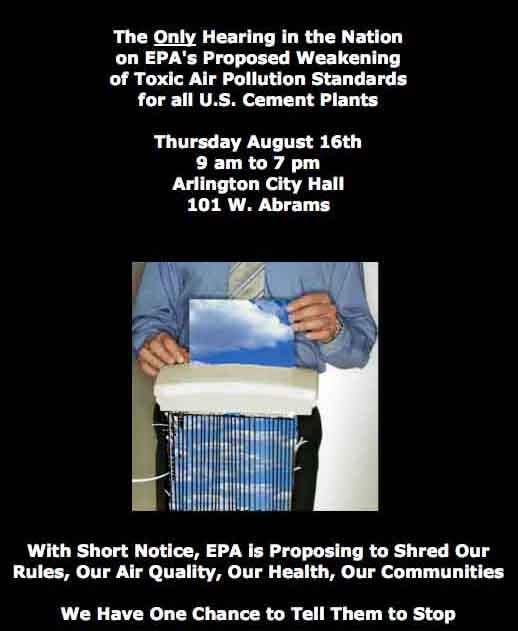EPA
Shocking Study: Air Pollution Regulations Improve Public Health
 One of the most basic arguments of industry opponents of clean air regulations is that they really don't do that much to improve public health. Given all the studies concluding that increases in air pollution lead to increases in illness and death, this argument is every bit as plausible as denying global warming at this point. But that doesn't stop industry and their supporters in elected office quit trying.
One of the most basic arguments of industry opponents of clean air regulations is that they really don't do that much to improve public health. Given all the studies concluding that increases in air pollution lead to increases in illness and death, this argument is every bit as plausible as denying global warming at this point. But that doesn't stop industry and their supporters in elected office quit trying.
Out of New York and via the Journal of Exposure Science and Environmental Epidemiology comes a three year study (2004-2006) that tracks decreases in ozone pollution to increases in public health, specifically fewer hospital admissions for respiratory problems. Overall, a decrease of about 9% in ozone pollution lead to an 11% decrease in hospitalizations. That's significant, bordering on one-to-one percentage point drop.
The study followed the progress of the EPA's NOx Budget Trading Program (BTP), a cap and trade system established for East Coat states to help them reduce their ozone, or smog pollution, that ran from 2004 to 2008, when it was replaced by the older, Bush-era version of the EPA's cross-stare pollution rules. It looked at all of New York in terms of eight regions throughout the state. Drops in smog averaged 9% but were substantially lower during the critical summer "ozone season."
According to the folks at the Environmental Health News:
"Regulations do work to lower pollution, which in turn can improve respiratory health.
Ozone levels decreased across the state of New York and hospital admissions for respiratory disease dipped in half of the regions studied after the EPA's regulatory program started. There were also notable decreases in hospital admissions for certain respiratory illnesses, most age groups and most health insurance groups.
The reduced admissions for those on public assistance suggests that low income residents may have benefited the most from air quality improvements. This would be an important achievement since this group often experiences the highest air pollution exposures.
These results are consistent with the limited number of other studies that compare pollution levels and health before and after required air pollution reductions."
It says more about the opposition to new regulations that we still have to have studies proving that less crap in the air means less illness and death. This has been a settled scientific fact for some time. But Industry pays big money for it to be a still-disputed political fact.
More Reaction to Ron Curry EPA Appointment
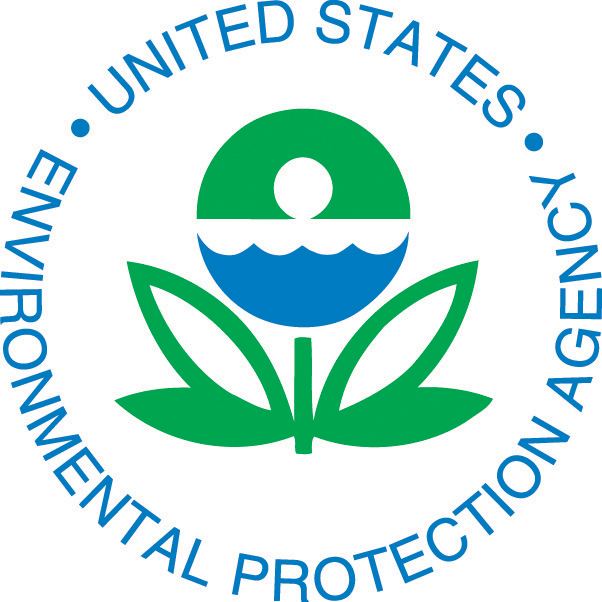 As news spreads that the Obama administration appointed former New Mexico state environmental chief Ron Curry to take Dr. Al's place as EPA Region 6 Administrator, reaction from stakeholders has been drifting in, including an already suspicious Senator Inhofe (R- Oil and Gas), who says that public comments made by Curry already raise concerns.
As news spreads that the Obama administration appointed former New Mexico state environmental chief Ron Curry to take Dr. Al's place as EPA Region 6 Administrator, reaction from stakeholders has been drifting in, including an already suspicious Senator Inhofe (R- Oil and Gas), who says that public comments made by Curry already raise concerns.
Here's an industry take from the Dallas Business Journal that helpfully combines the hucksters at the Barnet Shale Energy Education Council with the Texas Railroad Commission. And here's the Houston Chronicle talking to environmentalists in New Mexico.
While Curry seems to be a good choice, don't expect anything dramatic until after the election. Many observers were surprised the administration acted now to fill the slot instead of waiting until the dust had settled in favor of a second term.
Despite the change, the EPA won't find it any easier to deal with Austin as long as: a) Governor Perry is running for something, and b) Attorney General Greg Abbott is running for governor. Nothing personal Mr. Curry, you're just an ideological cartoon to be used for campaign fundraising.
As His Replacement is Announced, Dr. Al Speaks Out in Austin
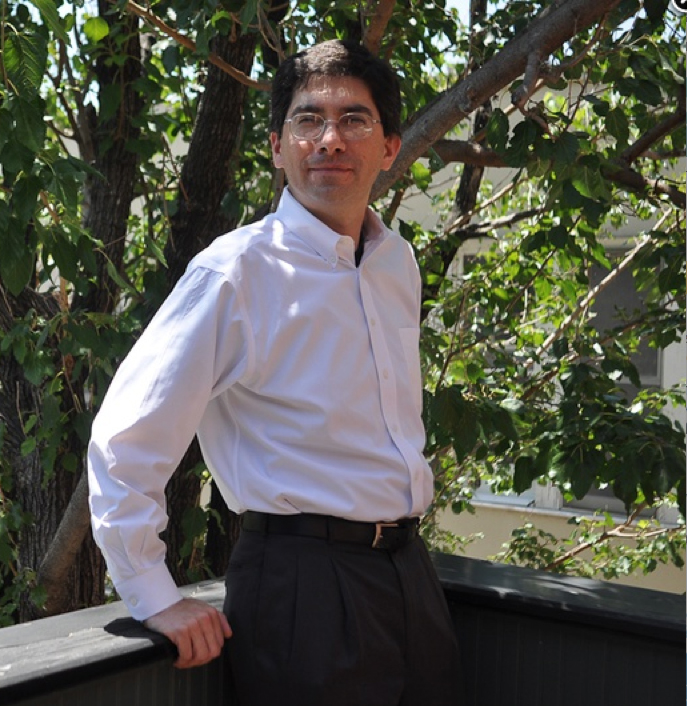 Maybe the EPA knew their former Region 6 Administrator Al Armendariz would be doing a one-on-one interview with the New-York Times-connected Texas Tribune as part of its annual festival on Saturday, or maybe it's just coincidence that the Agency named Armendariz's replacement very late Friday evening.
Maybe the EPA knew their former Region 6 Administrator Al Armendariz would be doing a one-on-one interview with the New-York Times-connected Texas Tribune as part of its annual festival on Saturday, or maybe it's just coincidence that the Agency named Armendariz's replacement very late Friday evening.
Whatever behind-the-scenes coordination did or did not take place, the appointment of New Mexico's Ron Curry as the new Region 6 chief gave Armendariz a slightly more removed historical perspective, and maybe willingness to talk, than he might have had otherwise.
Here's a live blogging of the interview that the Tribune's Evan Grant did with Armendariz from the Tribune festival itself in the middle of a forum on energy and the environment (11 am to 12 noon). Elizabeth Souder's recap for the Dallas Morning News is behind the paper's paywall, but here's a peak:
Former EPA regional admin Armendariz said anti-EPA court cases delay the inevitable
AUSTIN — Recent court cases striking down Environmental Protection Agency rules are just delaying the inevitable, said former regional EPA administrator Al Armendariz, who quit after a video surfaced showing him comparing his approach to Roman crucifixion.
Armendariz, who resigned as Region 6 administrator earlier this year and now works on an anti-coal campaign with the Sierra Club, said the agency will just re-write and re-apply the cross-state air pollution rule on coal plant emissions and its rejection of Texas’ flexible air permit rules. Some conservative Texas politicians regarded court decisions knocking down those rules as major victories.
Further, Armendariz said, the court decisions don’t show that the EPA was wrong. No, he said, the decisions show that the courts are wrong.
“They point out to me the importance of getting the President to appoint justices on the federal judiciary that will follow the law,” Armendariz said at a conference held by the Texas Tribune.
“I’m confident those actions, as written, were written completely in compliance with the law, and when those rules are revised that the agency is going to win any future litigation,” he said.
Armendariz defended his former employer and praised his successor at the Saturday appearance. He said the EPA and the White House have been working to implement the Clean Air Act and Clean Water Act, laws passed by Congress decades ago but never fully applied.
He criticized Texas environmental regulators who enable polluters, and called on energy regulators and lawmakers to create a plan to meet the state’s electricity needs with renewables.
Armendariz resigned in April after criticism over his comments in a video. In the video, he makes an analogy about his philosophy of enforcement. He said: “It was kind of like how the Romans used to conquer little villages in the Mediterranean. They’d go into a little Turkish town somewhere, they’d find the first five guys they saw and they’d crucify them. And then, you know, that town was really easy to manage for the next few years.
“And so you make examples out of people who are in this case not compliant with the law. Find people who are not compliant with the law, and you hit them as hard as you can and you make examples out of them, and there is a deterrent effect there.”
Arendariz on Saturday said he had apologized because his analogy offended people, which wasn’t his intent. But he didn’t back off the idea of deterring illegal polluting by punishing lawbreakers.
“I do stand behind the concept of my comments,” he said. “When you find someone who is violating the law, you do, within the boundaries of the law, vigorously prosecute.”
He said doing so ensures that illegal polluters don’t gain an unfair advantage over companies following the rules.
Texas Tribune chief executive Evan Smith said some people regarded the video as confirmation that Armendariz had it in for the energy industry.
Armendariz said such criticism was unfair, since in the video, he says his enforcement philosophy is for companies breaking the law.
Nor did he act alone by going after polluters. He said EPA administrator Lisa Jackson and her Washington staff had been “very involved with what we were doing in Texas.”
But he said leadership at the Texas Commission on Environmental Quality, the state regulatory arm of the EPA, is lax.
“There are some fantastic staff at TCEQ, and I think they’ve got poor leadership. I think the Governor’s appointees at that commission are preventing the staff from doing its job,” he said.
TCEQ chairman Bryan Shaw has criticized the EPA’s recent rules that would tighten regulations on coal plant pollution and greenhouse gas emissions.
And he praised his successor at the EPA, Ron Curry, the first non-Texan to lead the region that covers Texas, New Mexico, Oklahoma, Arkansas and Louisiana. The president announced the appointment last week.
“Ron is pragmatic, he’s very smart. He understands the need for conservation and the need for economic development,” Armendariz said.
Armendariz also said people who don’t believe in climate change are doomed to become irrelevant, just as doctors who don’t believe smoking causes cancer.
“I think the science of climate change is really irrefutable and those folks who are continuing to deny that climate change is a problem are really on the wrong side of history,” he said.
Now, Armendariz leads the Sierra Club’s anti-coal campaign, which aims to keep coal in the ground. He said so-called clean coal plants, which pollute less than traditional coal plants and capture greenhouse gases, are too expensive to justify coal mining.
“Clean coal I think is technically feasible, but I think it’s completely unnecessary,” he said.
He conceded the country will continue to use coal for the next decade. But he said coal isn’t necessary to keep the lights on.
The Electric Reliability Council of Texas has said the state is in danger of outages in the next few years because power plant developers haven’t build enough new generation to keep up with growing demand. The prospect of shutting down coal plants because of stiffer environmental regulations has left some regulators nervous about blackouts.
Armendariz said the reliability problem is due to a “complete lack of leadership and forethought.” He called on regulators and lawmakers to solve the problem with long-term planning and a vision centered on renewables, such as wind and solar.
Compare and Contrast
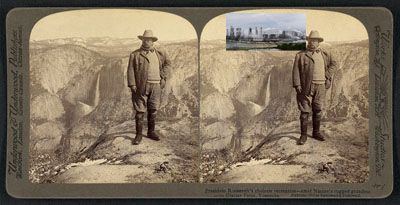 Read this obituary for Russell Train, the Republican conservationist creator of the Environmental Protection Agency, and then read the current Republican position on his creation.
Read this obituary for Russell Train, the Republican conservationist creator of the Environmental Protection Agency, and then read the current Republican position on his creation.
The Perry-TCEQ Plan for Cleaner Air: More Coal
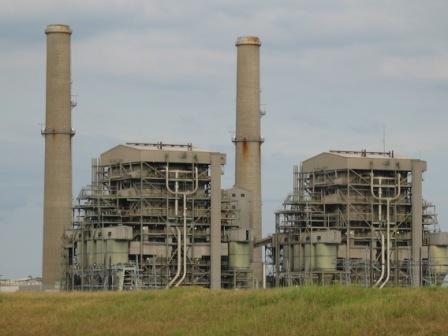 When it rains, it pours, or in this case, spews.
When it rains, it pours, or in this case, spews.
After getting a favorable ruling that struck down the EPA's flexible permit system last week, Team Perry seemingly scored another victory for its friends with Tuesday's ruling against the cross-state pollution rule.
Written by the Obama Administration to replace a similar Bush Administration rule that also got struck down by the courts (but is now back in at least partial effect…it hurts to think about this sometimes), the cross-state pollution rule was an attempt to federalize the problem of continental air pollution, much of it caused by big ol' dirty coal plants like the ones in East and Central Texas.
Texas can't regulate the coal plant pollution that wafts in from Illinois or Kentucky. Likewise, New York can't regulate Ohio facilities that send air pollution over its state lines. A federal solution covering all 50 states is required. Tuesday's ruling agreed, but concluded EPA hadn't given Texas and other states more time to come up with their own strategies to cut air pollution from coal plants. Maybe EPA was influenced by the fact that at the same time this strategy was being proposed, Governor Perry was rolling out plans to help streamline the permitting of 17 new coal plants in Texas.
Neither one of these rulings is as dreadful as it might seem at first. Both can be appealed. And both have mitigating circumstances that cushion the blow. With the flex permit case, all the facilities in Texas got standard operating permits eventually, making the ruling on the flex program itself moot. With the cross-state pollution rules, the Obama EPA itself said that two-thirds of all the health benefits from the rules had already been achieved with the partial implementation of the Bush rules they were meant to replace.
However, the cross state rules were not only supposed to be good in their own right, they also are the underpinning for a couple of other national pollution initiatives, including helping communities meet the new Ozone standard of 75 parts per billion, and the new, lower Particulate Matter pollution standard. Without the rules, these standards will be harder to achieve. And guess who's own plans begin to get mucked up by that failure? You guessed it, the state of Texas.
Because in the case of DFW's chronic smog problem, the Texas Commission on Environmental Quality had already factored compliance with the rule into its already obsolete 2012 clean air plan for the Metromess. That was one of the reasons we were going to see the lowest ozone levels ever recorded in DFW this summer. Without that backstop, it's going to be hard not only to just meet the old 1997 ozone standard of 85 ppb – something DFW has yet to do despite two official tries now over the last seven years – it's going to be hard to meet the much lower standard of 75 ppb.
If you've seen the TCEQ propaganda of the last couple of years, it touts how much pollution totals in Texas have decreased. The Commission uses these numbers to then promote the Perry Team philosophy of limited government intervention, suggesting that it's the TCEQ and Perry responsible for those declines. They are not. For the most part, what the state is touting are the results of federal programs that have decreased pollution systematically across the country – everything from new fuel and pollution standards for cars and trucks, to new federal standards for specific industries, like refineries and chemical plants. Throw in the things that federal citizen suits and pressure got done despite TCEQ – think cement plant pollution reduction in DFW for example – and you have most, if not all of the things reducing pollution in Texas that TCEQ is claiming credit for.
Without the cross state pollution rules, the oldest and dirtiest coal plants in Texas will continue to operate for the foreseeable future. And when the wind blows, some of their pollution will be breathed-in by DFW residents. In the short term, this is Team Perry's trophy for all you hard-working Texas residents – more crap in your lungs.
If the state keeps clearing away all the federal programs that have actually reduced pollution over the last 20-30 years, those total pollution numbers won't be going down much longer. They'll be holding even and then going up. Left to their own devices, Team Perry would have us living in a polluter's Pottersville. And then who will the Governor blame?
Thanks Much.
Thanks to everyone who showed-up on Thursday. More on Monday, but this will give you a run down on who spoke.
Citizens Plan to “Shred” EPA at Cement Plant Rules Hearing
 WHAT: The Nation's Only Public Hearing on the EPA's Rollback of Cement Plant Air Pollution Standards
WHAT: The Nation's Only Public Hearing on the EPA's Rollback of Cement Plant Air Pollution Standards
WHEN: 9am to 7 pm Thursday, August 16th
WHERE: Arlington City Hall, 101 W. Abram
(Arlington)—Opponents of an EPA proposal to rollback new cement plant air pollution standards will incorporate a paper shredder into their comments at an all day national EPA hearing at Arlington on Thursday.
"Sometimes words aren't enough to express your outrage. You need an action that speaks louder. Our shredder is pretty loud," said Downwinders at Risk Director Jim Schermbeck, whose group is leading an effort to recruit 100 speakers to fill every 5-minute speaking slot from 9 an to 7pm.
He and others plan to use the shredder to show the EPA what's at stake in the agency's last-minute reversal of key parts of the first ever national toxic air pollution emission standards.
They're bringing pictures of relatives with pollution-related illnesses, copies of the Clean Air Act, health care bills, and the EPA's iconic logo to feed into the shredder to help drive home the personal and public effects of the agency's proposed two-year delay and increase in soot pollution.
"With this regulatory mugging, EPA is shredding air quality, it's shredding public health, its shredding public confidence. We're just showing the results," said Schermbeck.
Despite only 11 days notice for a national hearing in the middle of August, he predicts citizens will come close to meeting their goal of filling all available speaking slots. It's the only hearing EPA is holding as it considers the changes to the original federal 2010 cement plant pollution standards that were hailed by the same groups now protesting a retreat.
Groups are expected to be joined in their rejection of the rollback by North Texas area elected officials or members of their staff, including Congresswoman Eddie Bernice Johnson, State House Representative Lon Burnam, Dallas County Judge Clay Jenkins, prospective Congressional Representative Mark Veasey, and State Senator Wendy Davis.
In 2009, approximately 90 people testified at a similar DFW hearing as the rules were up for final adoption. Dallas-Ft. Worth is downwind of the nation's largest concentration of cement plant manufacturing, with three large plants located within only a few miles of each other in Midlothian. The plants have been the center of environmental and health controversies since the late 1980's and made North Texas a hotspot of citizen opposition to industry pollution.
Having finally been adopted after 20 years of lawsuits, the new emission standards were on their way to be singed into law by President Obama this summer when EPA suddenly pulled them and announced they wanted to delay implementation from next year to 2015 while also loosening emission standards for Particulate Matter pollution. In evaluating the results of the revision, EPA admitted it will increase PM pollution from the nations cement plants by 135 tons a year.
Previous EPA studies had calculated how many lives would be saved by the standards. Citizens have seized on these estimates to now calculate the harm of the agency's two-year delay, putting the national death toll at between 2-5,000 lives using the EPA's own numbers.
Because of the amount of pollution generated in Midlothian and the population density of DFW, a significant portion of those deaths will be local residents.
No court ordered the after-the-fact revisions. In fact, the rules had survived their very last court challenge last December. Schembeck says that makes the rollback even more mysterious.
"EPA is going out of its way to deny citizens what they were on the verge of winning – the first ever federal air pollution standards for the nation's cement plants," Said Schermbeck. "They're robbing people who've been working on this issue for over 20 years for no good reason. We're not going to be quiet as they try to take away what we've rightfully earned."
Industry’s Man in the White House
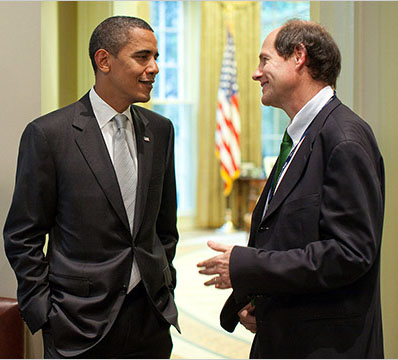 Not very many citizens realize the process that proposed environmental regulations have to go through in any administration in order to get out and published in he Federal Register in one piece. Not only does the regulation have to pass through the EPA's own cost-benefit analysis and survive various Congressional and court challenges, it must also pass through a murkier and more subjective test administered by the Office of Management and Budget, or OMB.
Not very many citizens realize the process that proposed environmental regulations have to go through in any administration in order to get out and published in he Federal Register in one piece. Not only does the regulation have to pass through the EPA's own cost-benefit analysis and survive various Congressional and court challenges, it must also pass through a murkier and more subjective test administered by the Office of Management and Budget, or OMB.
OMB is the very last stop an environmental regulation makes. There are no environmental scientists at OMB to judge the necessity of the regulation. No, OMB's job is to make sure the regulation doesn't hurt industry too much. That may seem like a worthwhile goal, but without any kind of strict guidelines for how to judge that, the conclusion is often open to a lot of interpretation. Industry knows that OMB is its last shot at stopping a regulation that otherwise has broad support form the public and even EPA. Among the non-profit environmental activists in DC, OMB is known as the place regulation go to die.
That's how last year's decision to leave the new ozone standard at 75 parts per billion, rather than the 70 ppb that EPA scientists had advocated – got done. Same thing for a weaker Particulate Matter standard this year. And we can't prove it yet, but we bet OMB had something to do with the rollback in cement plant emission rules being proposed suddenly by EPA/.
The face of the Obama Administration's OMB has been Cass Sunstein, head of the OMB's Office of Information and Regulatory Affairs (OIRA), a powerful department that holds sway over federal agency rulemakings. Having done his damage in the first Obama Administration, he recently announced he was leaving his job and returning to academia. But not before the DC publication "The Hill" got its hands on the e-mails Sunstein sent on behalf of the US Chamber of Commerce to get last year's ozone pollution standard weakened. In effect, he becomes a lobbyist on behalf of industry within the administration after industry has already lost the public health debate.
"The response to The Hill’s FOIA request shows Sunstein played an active role in alerting White House aides to business’s concerns about tightening the ozone standards. Internal communications show that ahead of the September decision, Sunstein circulated strong criticism of the ozone rule from a pair of powerful business groups, the National Association of Manufacturers (NAM) and the Business Roundtable, as well as House lawmakers opposing the tougher standards."
On July 15 of last year, Sunstein sent DeParle and two other aides a copy of a letter from the Business Roundtable to Daley, saying it was “worth reading.” The business group also released the letter publicly at the time.
On July 26, Sunstein sent a wider group of aides — including senior energy adviser Zichal and Phil Schiliro — a column titled “The Latest Job Killer From the EPA” that Business Roundtable President John Engler penned in The Wall Street Journal.
An un-redacted portion of the message from Sunstein states, “I am sure you saw this but just in case.
On Wednesday, Aug. 31, Sunstein forwarded several aides — including Stephanie Cutter, now a top Obama campaign official — an op-ed that NAM President and CEO Jay Timmons penned in The Hill attacking the ozone rule."
Please Take 5 Minutes to Defend What it Took Us 20 Years to Build
Nation’s Only Public Hearing on Roll Back of Cement Plant Rules Scheduled for Aug 16th in DFW
 Environmentalists are angry at EPA for giving the public less than two weeks notice prior to the nation's only hearing on a rollback of new air pollution rules for cement plants that the agency says could save thousands of lives annually, including many in DFW.
Environmentalists are angry at EPA for giving the public less than two weeks notice prior to the nation's only hearing on a rollback of new air pollution rules for cement plants that the agency says could save thousands of lives annually, including many in DFW.
One of those who came in 2009, and vowed to show up again on the 16th was Ft. Worth resident Margaret DeMoss, who was instrumental in getting her city to adopt a "green cement" policy to reduce pollution from obsolete Midlothian cement kilns in southern DFW.
She also noted that in 2009, when the rules were being proposed, there were three national hearings coast to coast. Now that the rules are being weakened, there's only one.
"It's outrageous that the EPA would schedule this hearing at the last minute and in only one location in the nation; lot of other regions suffer downwind from cement kilns. Who will speak for them?"
Downwinders at Risk and other community groups repeatedly sued to get them enforced. That effort resulted in 2010 emission rules that were hailed as the largest single advance in air quality for the US cement industry, and were universally supported by citizens living near and around the nation's cement plants.
They had already passed all necessary regulatory review, just overcome their last legal hurdle, and were on their way to President Obama for his signature and implementation by 2013 when they got yanked by the administration's Office of Management and Budget earlier this year.
When the rules re-emerged, their enforcement was pushed back to 2015 and their strict Particulate Matter pollution provisions were considerably weakened.
According to EPA's own health impact studies for the rules, that two-year delay will cause at least 2000-5000 premature deaths nationwide.
Despite a halt in the burning of hazardous wastes at local cement plants in 2010, MIdlothian remains the home of the largest concentration of cement manufacturing in the entire U.S.
Three large cement plants – TXI, Holcim, and Ash Grove – are still the largest point sources of air pollution in North Texas, generating thousands of tons of air pollution.
Since DFW is downwind of Midlothian, Metroplex residents are exposed to more cement plant pollution than any other metropolitan area in the country, and represent a disproportional number of these 2-5000 annual deaths that EPA estimates will occur because of its rules delay.
"If these revisions are adopted, DFW residents will be paying a high price for the Administration's retreat," said Schermbeck. "That's why we must make our objections heard now."
He urged those that want to speak at the August 16th hearing to reserve a five-minute slot with EPA coordinator Pam Garrett by e-mailing her at garrett.pamela@epa.gov or calling (919) 541-7966


